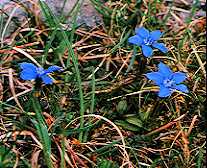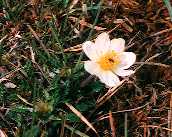
| Introduction | Flora of the Burren |
 |
|
The Burren is home to a unique array of plants. Species of Alpine and Mediterranean origin coexist in a landscape which is almost at sea level. The climate in the Burren is a mild maritime climate, free from extremes of temperature, and with a high annual rainfall. However, the winter brings strong winds which sweep along the harsh limestone pavements.
Many trees and shrubs exist in the Burren in a 'bonsai' form. The wind prunes the plants, so that they tend to spread out over the surface of the rocks rather than growing upwards. Limestone retains quite a lot of heat, so remaining close to these stones is a good idea! It is a common occurrence to see trees such as ash and sycamore growing no more than a few feet off the ground...
Following are pictures and a brief description of some of the plants to be seen around the Burren. May is usually the best month to see these plants in bloom:
| The Spring Gentian, Gentiana verna The spring gentian is the plant most commonly associated with the Burren. It's five petals of deep blue surround a centre of white. Flowering from mid April to mid June, this plant is abundant in the Burren, extremely rare elsewhere in Ireland, bar some occurrence on the Aran Islands. Sometimes one may be lucky enough to spot some of the variants of this plant for example the white-petaled var. chionodoxa. The gentian is an alpine plant, preferring high altitudes. However it thrives in it's Burren habitat. |
 |
| The Mountain Aven, Dryas octopetala The mountain aven is also found widely throught the Burren. The aven is a member of the rose family, and possesses white flowers with a golden centre. The plant can be seen in bloom in May and June, and often booms again until October. The mountain aven grows in great carpets, and is a remarkable sight when in bloom. After the flowers have passed, fluffy fruiting heads appear. The aven is considered an Arctic-Alpine plant |
 |
| The Early Purple Orchid, Orchis mascula The Burren is famous for its orchids, and over 20 species have been catalogued as growing here. The Early Purple Orchid is one of the first to appear, flowering in May. This orchid is characterised by dark spots present on its blunt leaves. Occasionally white Early Purples are seen around the Burren! |
 |
| The Fly Orchid, Ophrys insectifera The Fly Orchid is one of a few of the more unusual orchids in the Burren. Together with the Bee orchid, these plants lure insects to pollinate not by offering nectar or coloured flowers, but flowers which immitate the appearance of a particular species of insect. Insects are attracted in the hope of finding a mate, and as a result pollinate the plants! These orchids are not as common as some of the other species, and therefore are more difficult to find. |
 |
| The Wood Anemone, Anemone nemorosa The wood anemone is not unique to the Burren but is found in some abundance. Here it is seen growning like many plants in the 'grikes' (spaces between the stones) of the limestone pavement. Studies have shown that the atmosphere is rather constant in these grikes and offer an opportunity for plants like this to survive the harsh enviornment in the Burren |
 |
| Juniper, Juniperus communis Juniper is a shrub which is found widely in the Burren. it is a member of the pine family, and grows close to the ground, making it ideal for surviving in the Burren |
 |